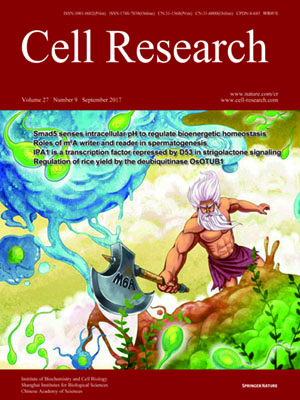Volume 27 Issue 9, September 2017: 1115-1127
ORIGINAL ARTICLES
Ythdc2 is an N6-methyladenosine binding protein that regulates mammalian spermatogenesis
Phillip J Hsu1,2,3,*, Yunfei Zhu4,*, Honghui Ma1,2,*, Yueshuai Guo4,*, Xiaodan Shi4, Yuanyuan Liu4, Meijie Qi4, Zhike Lu1,2, Hailing Shi1,2, Jianying Wang4, Yiwei Cheng4, Guanzheng Luo1,2, Qing Dai1,2, Mingxi Liu4, Xuejiang Guo4, Jiahao Sha4, Bin Shen4 and Chuan He1,2,5
1Department of Chemistry and Institute for Biophysical Dynamics, The University of Chicago, Chicago, IL 60637, USA;
2Howard Hughes Medical Institute, The University of Chicago, Chicago, IL 60637, USA;
3Committee on Immunology, The University of Chicago, Chicago, IL 60637, USA;
4State Key Laboratory of Reproductive Medicine, Department of Histology and Embryology, Nanjing Medical University, Nanjing 211166, China;
5Department of Biochemistry and Molecular Biology, The University of Chicago, Chicago, IL 60637, USA
Correspondence: Chuan He, E-mail: chuanhe@uchicago.edu; Bin Shen, E-mail: (binshen@njmu.edu.cn)
N6-methyladenosine (m
6A) is the most common internal modification in eukaryotic mRNA. It is dynamically installed and removed, and acts as a new layer of mRNA metabolism, regulating biological processes including stem cell pluripotency, cell differentiation, and energy homeostasis. m
6A is recognized by selective binding proteins; YTHDF1 and YTHDF3 work in concert to affect the translation of m
6A-containing mRNAs, YTHDF2 expedites mRNA decay, and YTHDC1 affects the nuclear processing of its targets. The biological function of YTHDC2, the final member of the YTH protein family, remains unknown. We report that YTHDC2 selectively binds m
6A at its consensus motif. YTHDC2 enhances the translation efficiency of its targets and also decreases their mRNA abundance. Ythdc2 knockout mice are infertile; males have significantly smaller testes and females have significantly smaller ovaries compared to those of littermates. The germ cells of Ythdc2 knockout mice do not develop past the zygotene stage and accordingly, Ythdc2 is upregulated in the testes as meiosis begins. Thus, YTHDC2 is an m
6A-binding protein that plays critical roles during spermatogenesis.
10.1038/cr.2017.99
FULL TEXT | PDF
Browse 1348


